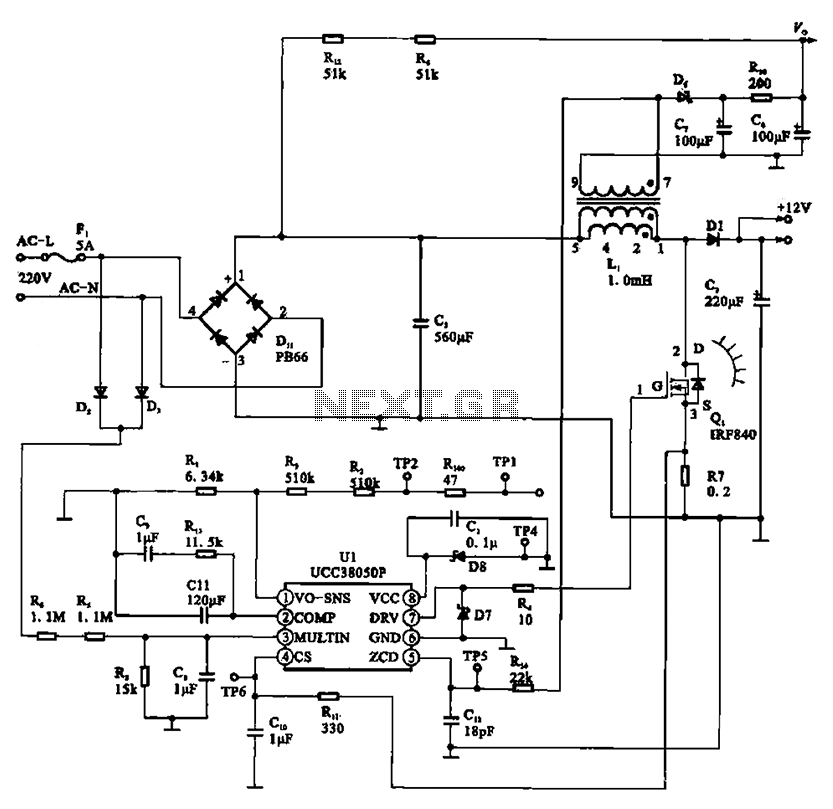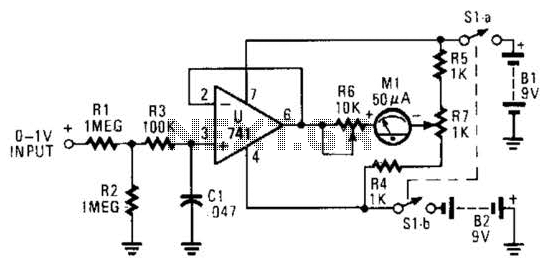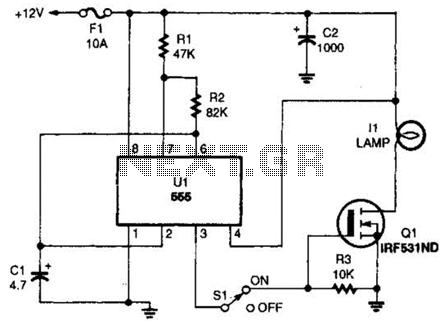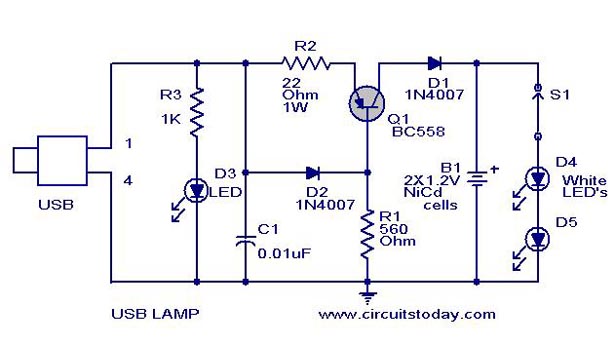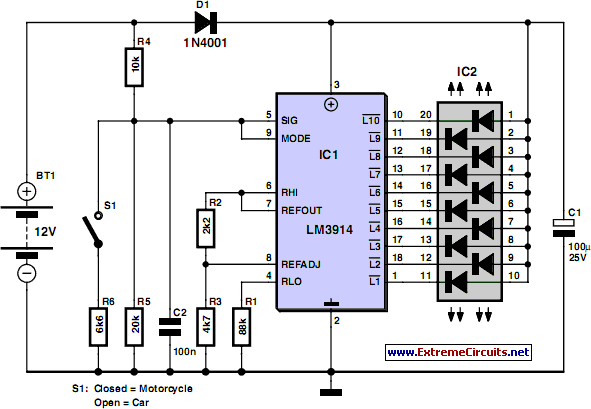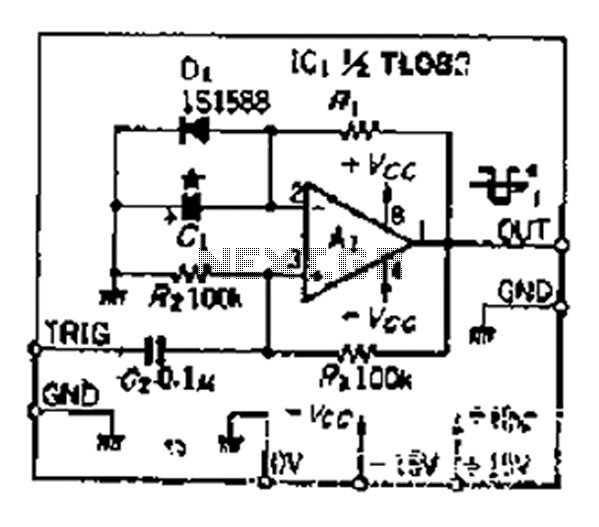
sound level meter circuit
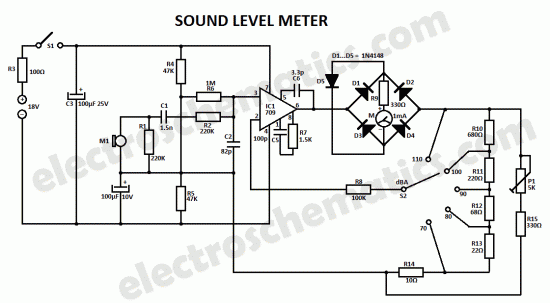
This sound level measuring device circuit can be used to control the intensity of a sound recording in the field of a disco. It has five measurement ranges between 70 and 120 dB, with a measurement accuracy of 0.5 dB. Microphone M1 receives the acoustic signal and is coupled to capacitors C1, C2, and resistors R1 and R2. These components, along with the microphone's output impedance and the amplifier's input impedance, form an input filter. The filtered signal is sent to operational amplifier IC1, whose sensitivity can be switched using S2 to correspond to the five measuring ranges. Diodes D1 to D4 rectify the alternating voltage at the amplifier output and feed the indicator tool through resistor R9. Diode D5 is used to protect the sound level gauge indicator from high voltages; it limits the rectifier's output voltage when the sound level is too high. Under normal conditions, the input current is approximately 2 mA, allowing the circuit to be powered by two 9V batteries. Switch S1 is used to disconnect the sound level measuring device after measurement. The indicator tool should accommodate a range of dB levels with a maximum gain of +10.
The sound level measuring device circuit is designed to provide an accurate and reliable measurement of sound intensity, particularly in environments such as discotheques where sound levels can vary significantly. The circuit operates within a specified range of 70 to 120 dB, making it suitable for various applications in sound engineering and audio production.
The heart of the circuit is the operational amplifier IC1, which is configured to amplify the signal received from the microphone. The microphone M1 captures sound waves and converts them into an electrical signal. This signal is then conditioned by the input filter formed by capacitors C1 and C2 and resistors R1 and R2, which eliminate unwanted noise and ensure that only the desired frequency components are passed to the amplifier.
The sensitivity of the operational amplifier can be adjusted using switch S2, which allows the user to select one of the five measurement ranges. This feature is particularly useful for adapting the instrument to different sound environments and ensuring accurate readings across a wide range of sound levels.
The output from IC1 is an alternating voltage that is rectified by diodes D1 to D4. The rectification process transforms the AC voltage into a DC voltage that can be easily read by the indicator tool. Resistor R9 is used to limit the current flowing to the indicator, ensuring that it operates within safe limits.
To protect the circuit from excessive voltage levels, diode D5 is included. This diode acts as a clamping device, preventing the output voltage from exceeding a certain threshold, which could otherwise damage the indicator or other circuit components.
Powering the circuit with two 9V batteries provides sufficient current for operation, with a typical input current of around 2 mA. This low power consumption allows for extended use in the field without frequent battery replacements. The inclusion of switch S1 enables the user to disconnect the circuit when not in use, further conserving battery life.
Overall, this sound level measuring device circuit is a practical tool for monitoring sound levels in various environments, providing users with the ability to ensure sound intensity is within acceptable limits for both safety and quality purposes.This sound level measuring device circuit can live used to control the intensity of a sound recording before in the field of a disco. It has 5 measurement domains connecting 70 and 120 dB; recital accuracy is 0. 5 dB. Microphone M1 is used to receive the acoustic imply and is coupled to C1, C2, R1 and R2. This components, composed with the micropho ne`s office and with the input impedance of the amplifier form an input filter. The filtered hint at goes to operational amplifier IC1 whose sensitivity can subsist switched with S2 corresponding to the five measuring domains. D1 D4 diodes rectifies the alternating voltage next to the amplifier output and feeds the indicator tool through R9.
D5 is used indoors order to watch over the sound level gauge indicator opposed to soaring voltages; it limits the rectifier`s output voltage after the sound level is too high. On standard conditions the input current is just about 2 mA to is why the circuit can live powered with 2 x 9V batteries.
S1 switch is used to disconnect the sound level gauge device afterward measurement. The indicator tool ought to tolerate a graded amount in the field of dB with the greatest extent profit of +10. 🔗 External reference
The sound level measuring device circuit is designed to provide an accurate and reliable measurement of sound intensity, particularly in environments such as discotheques where sound levels can vary significantly. The circuit operates within a specified range of 70 to 120 dB, making it suitable for various applications in sound engineering and audio production.
The heart of the circuit is the operational amplifier IC1, which is configured to amplify the signal received from the microphone. The microphone M1 captures sound waves and converts them into an electrical signal. This signal is then conditioned by the input filter formed by capacitors C1 and C2 and resistors R1 and R2, which eliminate unwanted noise and ensure that only the desired frequency components are passed to the amplifier.
The sensitivity of the operational amplifier can be adjusted using switch S2, which allows the user to select one of the five measurement ranges. This feature is particularly useful for adapting the instrument to different sound environments and ensuring accurate readings across a wide range of sound levels.
The output from IC1 is an alternating voltage that is rectified by diodes D1 to D4. The rectification process transforms the AC voltage into a DC voltage that can be easily read by the indicator tool. Resistor R9 is used to limit the current flowing to the indicator, ensuring that it operates within safe limits.
To protect the circuit from excessive voltage levels, diode D5 is included. This diode acts as a clamping device, preventing the output voltage from exceeding a certain threshold, which could otherwise damage the indicator or other circuit components.
Powering the circuit with two 9V batteries provides sufficient current for operation, with a typical input current of around 2 mA. This low power consumption allows for extended use in the field without frequent battery replacements. The inclusion of switch S1 enables the user to disconnect the circuit when not in use, further conserving battery life.
Overall, this sound level measuring device circuit is a practical tool for monitoring sound levels in various environments, providing users with the ability to ensure sound intensity is within acceptable limits for both safety and quality purposes.This sound level measuring device circuit can live used to control the intensity of a sound recording before in the field of a disco. It has 5 measurement domains connecting 70 and 120 dB; recital accuracy is 0. 5 dB. Microphone M1 is used to receive the acoustic imply and is coupled to C1, C2, R1 and R2. This components, composed with the micropho ne`s office and with the input impedance of the amplifier form an input filter. The filtered hint at goes to operational amplifier IC1 whose sensitivity can subsist switched with S2 corresponding to the five measuring domains. D1 D4 diodes rectifies the alternating voltage next to the amplifier output and feeds the indicator tool through R9.
D5 is used indoors order to watch over the sound level gauge indicator opposed to soaring voltages; it limits the rectifier`s output voltage after the sound level is too high. On standard conditions the input current is just about 2 mA to is why the circuit can live powered with 2 x 9V batteries.
S1 switch is used to disconnect the sound level gauge device afterward measurement. The indicator tool ought to tolerate a graded amount in the field of dB with the greatest extent profit of +10. 🔗 External reference
